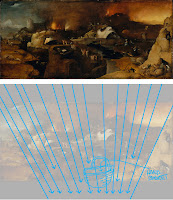 |
| “Madonna and Child,” by Bernardino da Asola. c. 1530. (The National Gallery, London, U.K.) |
Presumably, you are here because the title of this essay didn’t scare you away. It certainly scares me. The very word “composition” is enough to cause shudders among writers and artists alike. In the art realm, it’s an unnecessary idea that is applied, after the fact, to things we already know, but in no way wish to articulate.
Throughout art school I was faced with ever-present diagrams explaining the compositions of masterworks. The lines were superimposed on famous pieces of art. It was assumed that art students would follow the example and begin paintings with nearly invisible triangles and squares and straight lines circumscribed by larger circles, trapezoids and dodecahedrons and, in the process, create one great visual symphony. Meh. Years after school, I just do a painting and let someone else figure out the composition.
 |
| “Flaming June,” by Sir Frederic Leighton. 1895. (Museo de Arte de Ponce, Puerto Rico) |
I know, however, that you are not all artists. For that reason I thought I would take a few famous pieces and explain – perhaps as no teacher ever has – how each artist composed their work. I've superimposed a few lines to show the obvious [duh] composition. And in case you are wondering how I managed to get into the artists’ noggins, I can tell you with confidence that I did so using the technique real smart folks have used through history – by guess and by golly.
Let’s start with something simple – the stable triangle composition. Take any Madonna and Child painting, like the example above by Bernardino da Asola, and you’re guaranteed to have a stable triangle. Same goes with any painting of a pyramid. Or one of those signs on Amish buggies.
 |
| Orange and Yellow, 1956,” by Mark Rothko. 1956. (Albright-Knox Art Gallery, Buffalo, N.Y.) |
Now let’s flip that triangle. I hope you’re sitting down now, because this is an unstable triangle and your eyes might fall over. Sir Frederick Leighton was obviously knighted for using lots of triangles – most of them unstable. And for using Orange. Nice frame, though.
Okay, this is getting boring, so let’s look at Mark Rothko, the overachiever. Don’t try too hard Mark, even though I know your target audience consists exclusively of an oatmeal box and a paramecium.
 |
| “Beech Grove I,” by Gustav Klimt. 1902. (Galerie Neue Meister, Dresden, Germany) |
Gustav Klimt made use of lots of vertical line-thingies and an annoying, not-quite-horizontal line in his composition of a Beech grove. I really appreciate his work, but maybe someone should have given him a level for his birthday.
 |
| “Starry Night,” by Vincent Van Gogh. 1889. (Museum of Modern Art, New York) |
And what about everyone’s favorite, Vincent Van Gogh’s “Starry Night?” Vince did something wacky by using lots of circular lines in his mesmerizing composition. I took a stab at linking some of his circles with visual lines, and even threw in the Big Dipper for help, but all I could come up with was the Great Choo-Choo constellation, which obviously went off the tracks at some point in his life.
 |
| “Descent into Hell,” by Hieronymus Bosch. c. 1555 (The Metropolitan Museum of Art, New York) |
Some of the older pieces, like “Descent into Hell,” by Hieronymus Bosch, can give composition gurus hives. I mean, there’s so much going on in the painting – sight lines, counterbalance lines, azimuth lines, tangents and perpendicularities (Heheh, I made that one up). I’ve simplified things by just showing a bunch of lines going to hell in a hand basket. Makes sense to me.
I don’t think I’ve ever seen one of those composition diagrams superimposed on a Jackson Pollock painting, though. That just seems unfair, so you can thank me for helping you understand what’s visually going on in his painting. And when you DO understand, please tell me because, as is usually the case, I don’t have a clue.
 |
| “One Number 31, 1950” by Jackson Pollock. 1950. (Museum of Modern Art, New York) |
No comments:
Post a Comment